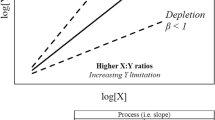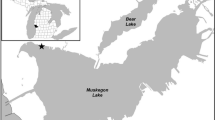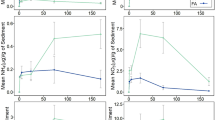Abstract
Nutrient patterns in wetlands are usually studied at a single sampling station and not for more than two or three hydrological years. This makes environmental assessment difficult, particularly when spatial heterogeneity and wetland responses depend upon water availability, as often occurs in Mediterranean wetlands. Furthermore, the spatial scale of environmental control of wetland dynamics is usually hypothesized to change as a result of water connectedness, so the higher the rate of water renewal, the larger the spatial scale of environmental control. To test this idea, we carried out a study of monthly nutrient loadings, organic carbon, total nitrogen, and phosphorus in a Spanish hypertrophic floodplain (Tablas de Daimiel National Park) for six years at three sites to ascertain the significance of both the spatial heterogeneity and the long-term responses of nutrient patterns to water availability. Our study demonstrated that strong site effects prevailed on nutrient chemistry in this wetland, irrespective of the degree of wetland connectivity, since there were very few significant correlations among different sites for a single nutrient and no significant correlations with loadings. Causes for this behavior might be that water inputs to this Mediterranean wetland were highly variable and leveling ecological effects were dampened by site processes. Spatially, an increasing gradient of total organic carbon and nitrogen occurred toward the outlet, but total phosphorus peaked in the middle of the wetland. Such a decoupling was also shown by PCA analysis where three different factors explained 69% of overall variability of nutrient patterns: flooding, both organic carbon and total nitrogen content, and total phosphorus. No temporal trend in nutrient content was observed. No simultaneous seasonal patterns were obvious in nutrient data from the same site or for the same nutrient at different sites. Periodicity analyses did not show overlapping of annual rhythms. That lack of patterns could be evidence of the major importance of site processes. This wetland behaved as a sink for nutrients, a fact also suggested by the increasing carbon and phosphorus content in sediments of all sites over time. Sediment nitrogen dynamics, however, might experience differential among-site processes resulting in no trend in accumulation in some areas. These results challenge current views on the spatial scale of environmental control on wetland performance and suggest that the role of water availability in ecological connectivity may be more complex than previously suspected.
Similar content being viewed by others
Literature Cited
Alvarez-Cobelas, M. and S. Cirujano (eds.). 1996. Las Tablas de Daimiel: Ecologia acuatica y Sociedad. Ministerio de Medio Ambiente, Madrid, Spain.
Alvarez-Cobelas, M., S. Cirujano, and S. Sánchez Carrillo. 2001. Hydrological and botanical man-made changes in the Spanish wetland of Las Tablas de Daimiel. Biological Conservation 97: 89–97.
American Public Health Association (APHA). 1989. Standard Methods for the Examination of Water and Wastewater, seventeenth edition. Washington DC, USA.
Amoros, C. and G. Bornette. 2002. Connectivity and biocomplexity in waterbodies of riverine floodplains. Freshwater Biology 47: 761–76.
Anderson, C. J. and W. J. Mitsch. 2006. Sediment, carbon, and nutrient accumulation over 10 years in created riparian marshes. Wetlands 26: 779–92.
Bachmann, R. W. and D. E. Canfield. 1996. Use of an alternative method for monitoring total nitrogen concentration in Florida lakes. Hydrobiologia 323: 1–8.
Bai, J., H. Ouyang, W. Deng, Y. Zhu, X. Zhang, and Q. Wang. 2005. Spatial distribution characteristics of organic matter and total nitrogen in marsh soils in river marginal wetlands. Geoderma 124: 181–92.
Barbiero, L., J. P. de Queiroz Neto, G. Ciornei, A. Y. Sakamoto, B. Capellari, E. Fernandes, and V. Valles. 2002. Geochemistry of water and groundwater in the Nhecolandia, Pantanal of Mato Grosso, Brazil: variability and associated processes. Wetlands 22: 528–40.
Davis, S. E., J. E. Cable, D. L. Childers, C. Coronado-Molina, J. W. Day, C. D. Hittle, C. J. Madden, E. Reyes, D. Rudnick, and F. Sklar. 2004. Importance of storm events in controlling ecosystem structure and function in a Florida Gulf Coast estuary. Journal of Coastal Research 20: 1198–1208.
Drbal, K. and O. Rauch. 1996. Water chemistry. p. 47–52. In K. Prach, J. Jenik, and A. R. G. Large (eds.) Floodplain Ecology and Management. SPB Academic Publishing, Amsterdam, The Netherlands.
Golterman, H. L. 2004. The Chemistry of Phosphate and Nitrogen Compounds in Sediments. Kluwer Academic Publishers, Dordrecht, The Netherlands.
Hoberg, P., M. Lindholm, L. Ramberg, and D. O. Hessen. 2002. Aquatic food web dynamics on a floodplain in the Okavango Delta, Botswana. Hydrobiologia 470: 23–30.
Hopkinson, C. S. 1992. A comparison of ecosystem dynamics in freshwater wetlands. Estuaries 15: 549–62.
Howard-Williams, C. 1985. Cycling and retention of nitrogen and phosphorus in wetlands: a theoretical and applied perspective. Freshwater Biology 15: 391–431.
Johnston, C. A. 1991. Sediment and nutrient retention in freshwater wetlands: effects on surface water quality. Critical Reviews in Environmental Control 21: 491–566.
Kadlec, R. H. and R. L. Knight. 1996. Treatment Wetlands. CRC Lewis Publishers, Boca Raton, FL, USA.
Kavvas, M. L. and J. W. Delleur. 1975. Removal of periodicities by differencing and monthly mean substraction. Journal of Hydrology 26: 335–53.
Leibowitz, S. G. and K. C. Vining. 2003. Temporal connectivity in a prairie pothole complex. Wetlands 23: 13–25.
McCormick, P. V., S. Newman, S. Miao, D. E. Gawlik, D. Marley, K. R. Reddy, and T. D. Fontaine. 2002. Effects of anthropogenic phosphorus inputs on the Everglades. p. 83–126. In J. W. Porter and K. G. Porter (eds.) The Everglades, Florida Bay, and Coral Reefs of the Florida Keys: An Ecosystem Sourcebook. CRC Press, Boca Raton, FL, USA.
Miller, R. G. 1981. Simultaneous Statistical Inference, second edition. Springer-Verlag, New York, NY, USA.
Mitsch, W. J., C. L. Dorge, and J. R. Wiemhoff. 1979. Ecosystem dynamics and phosphorous budget of an alluvial cypress swamp in Southern Illinois. Ecology 60: 1116–24.
Mitsch, W. J. and J. G. Gosselink. 2001. Wetlands, third edition. John Wiley & Sons, Inc, New York, NY, USA.
Mitsch, W. J., L. Zhang, C. J. Anderson, A. Altor, and M. Hernandez. 2005. Creating riverine wetlands: ecological succession, nutrient retention, and pulsing effects. Ecological Engineering 25: 510–27.
O’Connell, M. D. S. Baldwin, A. I. Robertson, and G. Rees. 2000. Release and bioavailability of dissolved organic matter from floodplain litter: influence of origin and oxygen levels. Freshwater Biology 45: 333–42.
Rains, M. C., G. E. Fogg, T. Harter, R. A. Dahlgren, and R. J. Williamson. 2006. The role of perched aquifers in hydrological connectivity and biogeochemical processes in vernal pool landscapes, Central Valley, California. Hydrological Processes 20: 1157–75.
Ribeiro, M. D. 2005. Biologia de los macrofitos emergentes en Las Tablas de Daimiel. Ph.D. Dissertation. Universidad Complutense, Madrid, Spain.
Ribeiro, M. D., M. Alvarez-Cobelas, P. Riolobos, and S. Cirujano. 2004. Descomposicion de los helofitos en un humedal semiarido hipertrofico. Anales del Jardin Botanico de Madrid 61: 53–61.
Rojo, C., E. Ortega, M. A. Rodrigo, and M. Alvarez-Cobelas. 2000. Phytoplankton structure and dynamics in the semiarid wetland National Park Las Tablas de Daimiel (Spain). Archiv für Hydrobiologie 148: 397–419.
Rose, C. and W. G. Crumpton. 1996. Effects of emergent macrophytes on dissolved oxygen dynamics in a prairie pothole wetland. Wetlands 16: 495–502.
Sánchez-Carrillo, S. and M. Alvarez-Cobelas. 2001. Nutrient dynamics and eutrophication patterns in a semiarid wetland: the effects of fluctuating hydrology. Water, Air and Soil Pollution 131: 97–118.
Sánchez-Carrillo, S., D. G. Angeler, R. Sanchez-Andres, M. Alvarez-Cobelas, and J. Garatuza. 2004. Evapotranspiration in semiarid wetlands: relationships between inundation and the macrophyte cover:open water ratio. Advances in Water Resources 27: 643–55.
Soil Science Society of America. 1971. Instrumental Methods for Analysis of Soil and Plant Tissue. Phosphorus 7: 334.
Stribling, J. M. and J. C. Cornwell. 2001. Nitrogen, phosphorus, and sulfur dynamics in a low salinity marsh system dominated by Spartina alterniflora. Wetlands 21: 629–38.
Tockner, K., A. Pennetzdorfer, N. Reiner, F. Schiemer, and J. V. Ward. 1999. Hydrological connectivity, and the exchange of organic matter and nutrients in a dynamic river—floodplain system (Danube, Austria). Freshwater Biology 41: 521–35.
Turner, R. E. 1999. A comparative mass balance budget (C, N, P and suspended solids) for a natural swamp and overland flow systems, p. 61–71. In J. Vymazal (ed.) Nutrient Cycling and Retention in Natural and Constructed Wetlands. Backhuys Publishers, Leiden, The Netherlands.
van Geest, G. J., H. Coops, R. M. M. Roijackers, A. D. Buijse, and M. Scheffer. 2005. Succession of aquatic vegetation driven by reduced water-level fluctuations in floodplain lakes. Journal of Applied Ecology 42: 251–60.
Verhoeven, J. T. A., A. Keuter, R. van Logtestijn, M. B. Kerkhoven, and M. Wassen. 1996. Control of local nutrient dynamics in mires by regional and climatic factors: a comparison of Dutch and Polish sites. Journal of Ecology 84: 647–56.
Verhoeven, J. T. A., D. F. Whigham, R. van Logtestijn, and J. O’Neill. 2001. A comparative study of nitrogen and phosphorus cycling in tidal and non-tidal riverine wetlands. Wetlands 21: 210–22.
Wetzel, R. G. 2001. Limnology, third edition. Academic Press, San Diego, CA, USA.
Whigham, D., M. Pittek, K. H. Hofmockel, T. Jordan, and A. L. Pepin. 2002. Biomass and nutrient dynamics in restored wetlands on the outer coastal plain of Maryland, USA. Wetlands 22: 562–74.
Wilcox, D. A., J. E. Meeker, P. L. Hudson, B. J. Armitage, M. G. Black, and D. G. Uzarski. 2002. Hydrologic variability and the application of Index of Biotic Integrity metrics to wetlands: a Great Lakes evaluation. Wetlands 22: 588–615.
Winter, T. C. 1989. Hydrologic studies of wetlands in the Northern Prairie. p. 16–54. In A. van der Valk (ed.) Northern Prairie Wetlands. Iowa State University Press, Ames, IA, USA.
Author information
Authors and Affiliations
Corresponding author
Rights and permissions
About this article
Cite this article
Alvarez-Cobelas, M., Sánchez-Carrillo, S. & Cirujano, S. Strong site effects dictate nutrient patterns in a Mediterranean floodplain. Wetlands 27, 326–336 (2007). https://doi.org/10.1672/0277-5212(2007)27[326:SSEDNP]2.0.CO;2
Received:
Revised:
Accepted:
Issue Date:
DOI: https://doi.org/10.1672/0277-5212(2007)27[326:SSEDNP]2.0.CO;2




